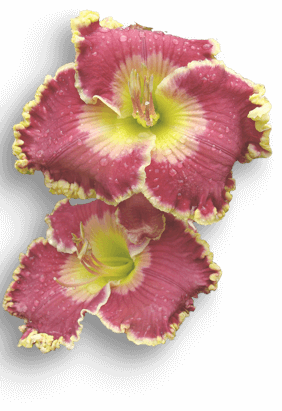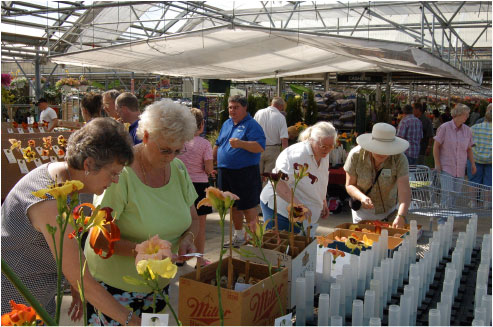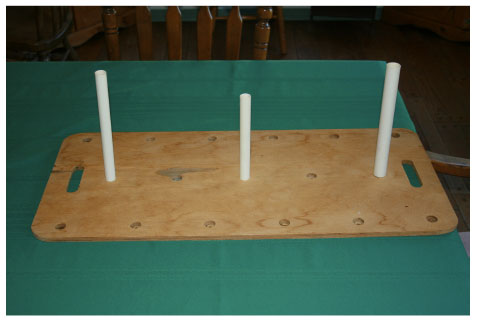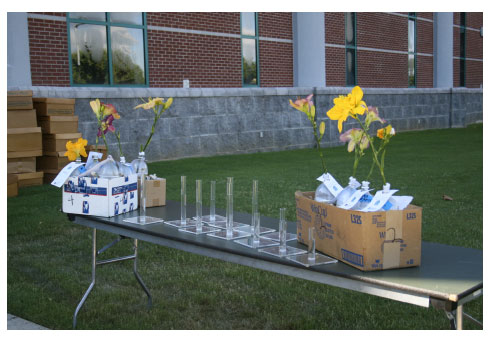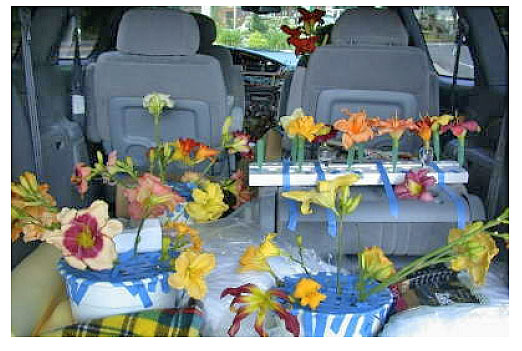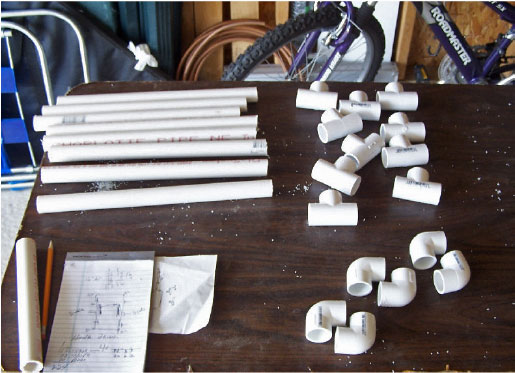January 20, 2022
Transporting Daylilies for Exhibition
Written by Nikki Schmith, with credit to Nancy and John Falck
How to transport daylilies to an Exhibition Show is one of the most asked questions by people who want to get into the fun of exhibiting daylilies. There is no hard and fast answer for those who are looking for the “best” way to do this. Years of experience and personal trials will reveal which method is best for you, but in the meantime, here are a few examples of what others have done across the country in their quest for Best In Show.
The carrier shown below is easy to make, easy to fill with water, and easy to arrange all sizes and heights of daylily scapes by alternating the sizes of PVC tubes.
The plywood is 1/2 inch plywood cut to 32 x 14 1/2 inches. A hand holder
opening is cut at each end.
The holes routed to fit the tubes do not go all the way through the plywood.
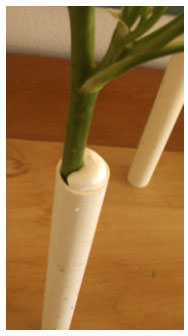 The tubes are cut to various lengths and plugged with a plumbing sealant filled at the bottom. It is used for aquariums and such also. The best way is to plug the hole, let it set, test, and reapply if needed. Do not glue the PVC to the board. The PVC should remain removable for easy storage and flexibility.
The tubes are cut to various lengths and plugged with a plumbing sealant filled at the bottom. It is used for aquariums and such also. The best way is to plug the hole, let it set, test, and reapply if needed. Do not glue the PVC to the board. The PVC should remain removable for easy storage and flexibility.
You can see in the image on the left, once scapes are placed in the PVC tubes, the s-curved foam peanuts stabilize scapes. Be careful with scapes knocking against the side of the PVC, as this can cause damage that cannot be repaired. Although nothing below the rim of the exhibition container is judged, if your scape is scraped up during transport, you can never be sure if that part will be above the exhibition container rim.
Storage is the best feature of this transport method as the tubes lie flat in a box or bin and the boards stack flat. Since each “tray” carrier holds approximately 17 scapes you can carry a large number safely to a show.
Two other methods, seen below, show innovation in practice. On the left, you see a 5-gallon bucket with what looks like wire mesh over the top to allow for scapes to sit inside. The two wooden carriers are obviously the result of some engineering skill and imagination! The small dowels running horizontally (see arrow below) definitely provide for additional support for scapes, as a pipe cleaner (soft surface will not damage scapes), can secure the taller scapes to the cross bar for stability while travelling.
5-gallon buckets seem to be the carrier of choice for many. Not only can you use this with chicken wire over the opening, you can stuff them with rolled up newspaper, cut-to fit pool noodles, PVC pipes, and many other options can be inserted in the bucket.
In the next photo, a recycling bin was raided to reuse 2-liter soda bottles as carriers. Using a USPS Priority Mail box (free at your post office), this exhibitor was able to fit four or more bottles for transporting. Note the cotton balls or foam plugs in the bottle openings to provide additional stability for the scapes.
Where there is a will there is a way. Cecil Daniels transported these scapes in his convertible all the way from Jackson to Hattiesburg to win. He ultimately won an Ophelia Taylor award. No fear and how fun!
In this photo, painters tape was the weapon of choice to not only build a net for the bucket lids, but to secure the foam blocks to the seats for safety. Many a winning exhibit has been damaged on the way to the show! This exhibitor was taking no chances.
Foam and floral picks are a great pair. Once you find yourself on the lookout for large squares of Styrofoam, you will find it is easy to get your hands on. As a last resort, if you cannot find any to recycle, major craft stores do sell it in large sheets at a reasonable price. The foam and sheets usually only work well for transporting off scape blooms to the show or even to a meeting.
 Gloria Hite, from Michigan, uses her city recycling bin and PVC lengths to transport her
Gloria Hite, from Michigan, uses her city recycling bin and PVC lengths to transport her
scapes. She also has a high-tech carrier system built and used by her late father,
renowned hybridizer Howard Hite.
Don’t forget that your scapes will be happier in water as you transport them to the
show, so whatever container you build, make sure you plan for water weight and retention.
More examples follow of 5-gallon buckets, boxes, soda bottles and wine boxes.
 Even a small cooler can be modified to transport scapes to the show. This would be a perfect transporter for shorter scapes with smaller flowers, and would fit nicely on the front floorboard of the car.
Even a small cooler can be modified to transport scapes to the show. This would be a perfect transporter for shorter scapes with smaller flowers, and would fit nicely on the front floorboard of the car.
Remember to leave time in your morning to get these devices safely into the car. You do not want to spend two hours selecting and cutting scapes, only to be shoving them into the car in order to get to the show on time. One exhibitor I know places the carriers in the car FIRST, then loads the individual scapes into them. Using this method, she is less likely to bump and bruise any of the blooms trying
to shoehorn it into the car. She also knows whether the device fits into the car with the scapes if she if placing them one at a time.
There are a few things you should remember regardless of what type of container you use to transport daylilies to the show. In no particular order, and not meant to be an exhaustive list, here are a few:
- Secure the scapes inside the container with cotton, foam or other soft material.
- Make sure the scapes cannot rotate around in the containers. Spinning scapes can damage each other.
- Transporting scapes with water is desired. Blooms will retain freshness.
- Do not place too many scapes in your container. Why cut the scape at all if you are not going to do everything you can to ensure it at least makes it to the show location?
- Intersperse tall scapes with short ones in your container.
- Secure the device in your car by either taping it to the floorboard or padding the sides.
This next transporting method cost about $10 in materials and 2 hours worth of work. Each carrier holds 8 scapes, which is a nice, manageable number for one carrier. It also has a handle and is easily carried into the show location. It also holds water and is very lightweight when full of water and scapes.
Here are the materials used to make one carrier:
- 8 lengths of ½” PVC pipe cut to varying lengths of 12″ to 18″
- 2 lengths of ½” PVC pipe cut to 24″ for the handle sides
- 12 – 2″ lengths of ½” PVC pipe to build the bottom of the carrier
- 3 lengths of ½” PVC pipe cut to 8″ to form the ends of the bottom of the carrier and the handle
- 6 PVC elbows
- 10 PVC T-joints
- Plumbers sealant
Further thought after this project was finished revealed that 1″ PVC pipe would have been more ideal for transporting thicker scapes, and smaller scapes could still fit in with the use of foam peanuts or foam squares. You may want to consider this if you are building this carrier.
Each carrier holds 8 scapes and has a handle that is taller than the scape holders for ease of use. What is not shown in the “pieces” photo are the small, 2″ lengths of PVC used to connect the t-joints for the base, the 3 lengths used for the sides of the bottom and the handle pieces. Once all the pieces were cut, it went together very quickly.
Plumber’s glue was used to seal the bottom of each scape tube. The round elbows were used for the corners of the base and the top of the handle. 4 of these slide very nicely lengthwise into the back of a large SUV, and when filled with about 4 inches of water, they are very stable.
The fully assembled carrier is shown below in action at a 2009 Exhibition show in Michigan.
 Exhibiting daylilies is the ultimate illustration of pleasure and pain. It is hard to cut scapes, groom, transport, classify, place, judge and be a successful exhibitor, but there isn’t much like seeing your entries on the head table.
Exhibiting daylilies is the ultimate illustration of pleasure and pain. It is hard to cut scapes, groom, transport, classify, place, judge and be a successful exhibitor, but there isn’t much like seeing your entries on the head table.
The best advice is to have fun and know what you are getting into. Read the show schedule. Talk to other exhibitors. Read the Judging Daylilies handbook to be educated as to how your flowers will be judged. Did I say have fun?
HAVE FUN!
Two days or so before the show:
- Take a walk around your garden a few days before the show to see what may be opening show day.
- In these few days before the show, keep your garden deadheaded in order to make sure spent blooms do not interfere with new ones opening.
- It is not recommended to overhead water the couple days before the show. Some blooms can get “water-stained.”
- Look for scapes that are straight and close to registered height.
- Select scapes that have little insect damage, or have damage that you can clean.
The day before the show:
- Fill out your tags with your name and address on both parts of the tag.
- Get the Official Show Schedule and figure out which sections the flowers you will be showing fit in to. Use the Daylily Database Advanced Search to verify.
- Get your transporting containers ready to go. Build a contraption that will FIT INTO YOUR CAR, and is light enough to carry.
The morning of the show:
- Don’t select more daylilies than you can groom in time for the show.
- Don’t select so many daylilies that they will be crammed in your transporting device and ruin each other on the way to the show.
- Remember the large flower section is usually the one with the most flowers, so try to pick flowers from other sections, too.
- Do as much grooming as you can at home. The show location is crazy.
The American Daylily Society
